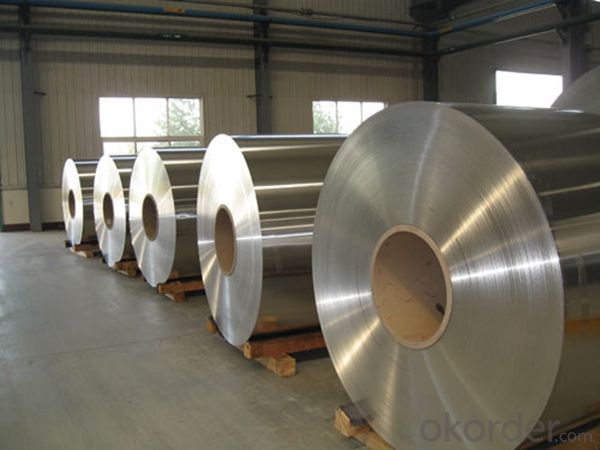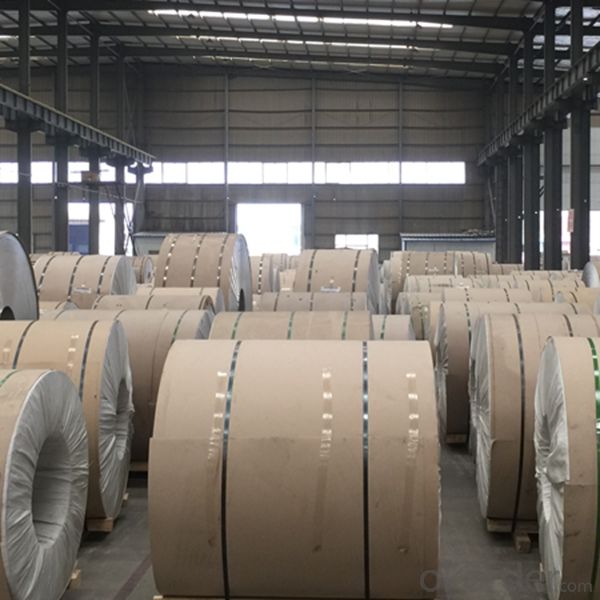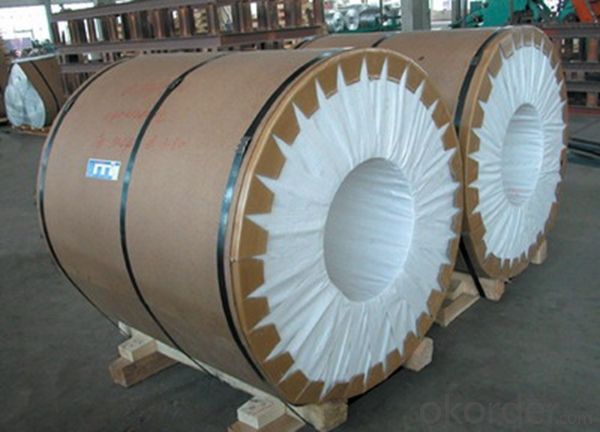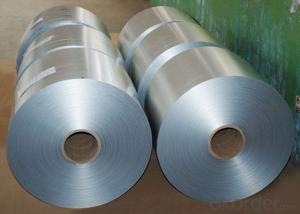Mill Finish Aluminium Coil 3003 H14 for Color Coating
- Loading Port:
- Shanghai
- Payment Terms:
- TT OR LC
- Min Order Qty:
- 5 m.t.
- Supply Capability:
- 10000 m.t./month
OKorder Service Pledge
OKorder Financial Service
You Might Also Like
Item specifice
1. Specification of Mill Finish Aluminium Coil 3003 H14 for Color Coating
Material | Alloy Aluminum 1XXX,3XXX,5XXX or customer nominated |
Temper | T3, T4, T5, T6 |
Surface | Anodize, electrophoresis, powder coating,PVDF coating, wood grain painting, matted, etc. |
Colour | Any colour based on Standard Germany RAL Mark |
Length | Coating 6.5 meters, Anodizing 6.5 meters, Mill finish 5 meters |
Press Machine | 500-4000 tons all together 64 press lines. |
Fabrication | 1. Windows and doors; 2. Drilling; 3. Bending; 4. Cutting; 5. etc. |
Certificate | ISO 9001 |
Moulding | 1. Using our moulds, no fee; |
2. Using customer drawing, opening mould, usually about 10~50 tons then the moulding can be refunded. | |
3. Mould cost is negotiable base on the order quantity | |
Capability | Annual output 100,000 tons |
2. Application of Mill Finish Aluminium Coil 3003 H14 for Color Coating
(1).Interior: wall cladding, ceilings, bathrooms, kitchens and balconies, shutters, doors...
(2).Exterior: wall cladding, facades, roofing, canopies, tunnels,column covers , renovations...
(3).Advertisement: display platforms, signboards, fascia, shop fronts...
3. Feature of Mill Finish Aluminium Coil 3003 H14 for Color Coating
Be free from Oil Stain, Dent, Inclusion, Scratches, Stain, Oxide Dicoloration, Breaks, Corrosion, Roll Marks, Dirt Streaks and other defect which will interfere with use
4. Certificate:
SGS and ROHS(if client request, paid by client), MTC(plant provided), Certificate of Origin(FORM A, FORM E, CO), Bureau Veritas and SGS (if client request, paid by client), CIQS certificate
5. Image of Mill Finish Aluminium Coil 3003 H14 for Color Coating





6. Package and shipping of Mill Finish Aluminium Coil 3003 H14 for Color Coating
eye to wall
eye to the wall
with wood pallet (wooded case also available)
7. FAQ
1) What is the delivery time?
Dpends on actual order, around 20 to 35 days
2)What is the QC system:
We have QC staff of 20 persons and advanced equipment, each production is with MTC traced from Aluminum ingot lot.
3) What market do you mainly sell to?
Australia, America, Asia, Middle East, Western Europe, Africa etc
- Q:I'm having trouble with another chem problemAluminum sulfide reacts w/water to form aluminum hydroxide and hydrogen sulfide. Write the balanced chemical equation for this reaction and find how many grams of aluminum hydroxide are obtained from 14.2 g of aluminum sulfide.I already found the balanced equation but I need help on finding how many grams of aluminum hydroxide are obtained from 14.2 g of aluminum sulfide. Can someone please explain how it's done?
- You use the given grams of Aluminum Sulfide, and use stoichiometry. First convert the Aluminum Sulfide from grams to moles [14.2g (1 mole of Aluminum Sulfide/total mass of Aluminum sulfide)]. Then, set up a mole ratio of Aluminum Sulfide to Aluminum Hydroxide (you do this by creating a ratio of the coefficients of both Aluminum Sulfide and Aluminum Hydroxide from your balanced equation; moles of Aluminum Hydroxide/miles of Aluminum Sulfide). And then finally convert back to grams (total mass of Aluminum Hydroxide/ 1 mole of Aluminum Hydroxide). In total, it should look like this: [14.2(1 mol Al Sulfide/mass of Al Sulfide)(mols of Al Hydroxide/mols of Al Sulfide)(mass of Al Hydroxide/1 mol of Al Hydroxide)]
- Q:Are aluminum coils suitable for architectural cladding applications?
- Aluminum coils, indeed, are well-suited for architectural cladding applications. The versatility of aluminum as a material offers a multitude of advantages when it comes to cladding purposes. To begin with, aluminum's lightweight properties make it effortlessly manageable and installable. This not only lessens the burden on the building structure but also simplifies the construction process as a whole. Moreover, aluminum exhibits exceptional durability and resistance against corrosion. Consequently, it becomes an ideal selection for exterior applications, withstanding even the harshest of weather conditions while preserving its appearance over time. In addition to its durability, aluminum coils possess the ability to be fabricated into various shapes and sizes, allowing for a flexible design approach. They can be effortlessly formed, cut, and molded to precisely meet the specific requirements of any given building project. Architects and designers also benefit from the wide range of finishes and colors available in aluminum. This provides them with ample options to achieve the desired aesthetic for the cladding. Furthermore, opting for aluminum aligns with the growing emphasis on environmentally friendly construction practices, as it is entirely recyclable. Overall, the myriad of advantages, including versatility, durability, lightweight nature, aesthetic options, and sustainability, make aluminum coils a fitting choice for architectural cladding applications.
- Q:Can aluminum coils be used in signage applications?
- Indeed, signage applications can make use of aluminum coils. The durability, corrosion resistance, and lightweight characteristics of aluminum render it a favored material for signage purposes. Aluminum can effortlessly take on different shapes and sizes, making it suitable for a wide range of signage types, including outdoor signs, billboards, trade show displays, and more. Furthermore, aluminum coils boast exceptional weather resistance, guaranteeing the preservation of the signage's integrity and vibrancy even in harsh environmental circumstances. The versatility and longevity of aluminum establish it as the preferred option for signage applications across diverse industries.
- Q:What is a better deal?Aluminum Cookware ( Paula Deen)orHard Anodized ( Rachael Ray )
- Neither. For one, stainless steel is the way to go. Secondly, with both of those you're paying more for the celebrity endorsement than you are the quality of the product. Go with All-Clad. If it's too expensive, you're better off deciding on a few pieces that you'll use the most and buying quality rather than an entire set.
- Q:How to calculate the weight of strips with the weight of aluminum coil known?
- Thickness*width*length=weight/density, length=weight/(density*thickness*width).Ps: Keep unit the same.
- Q:What are the different thickness options for aluminum coils?
- Various industrial and commercial applications can be catered to with a wide range of thickness options for aluminum coils. The thickness of these coils is typically measured in gauge or millimeters (mm). Aluminum coils are available in different thickness options: 1. Thin Gauge: Coils with a thin gauge usually have a thickness ranging from 0.15 mm to 0.4 mm. These coils are commonly utilized in applications that necessitate lightweight and flexible materials, such as packaging, electrical wiring, and insulation. 2. Standard Gauge: Coils with a standard gauge have thicknesses ranging from 0.4 mm to 2.5 mm. They find widespread use in industries like construction, automotive, and aerospace for applications like roofing, cladding, heat exchangers, and structural components. 3. Thick Gauge: Coils with a thick gauge typically have a thickness above 2.5 mm. These coils are predominantly employed in heavy-duty applications that require high strength, durability, and load-bearing capacity. Examples include shipbuilding, industrial machinery, and large-scale structural frameworks. It is important to note that the availability of specific thickness options may vary depending on the manufacturer and the intended application. Additionally, custom thicknesses can be manufactured to meet specific project requirements.
- Q:Can aluminum coils be used in heat sinks?
- Yes, aluminum coils can be used in heat sinks. Aluminum is a popular choice for heat sinks due to its excellent thermal conductivity. Heat sinks are designed to dissipate heat from electronic components and other devices to prevent overheating. The use of aluminum coils in heat sinks allows for increased surface area, which enhances heat dissipation. The coils can be shaped and arranged in various configurations to optimize cooling efficiency. Additionally, aluminum is lightweight, corrosion-resistant, and cost-effective, making it a practical choice for heat sink applications.
- Q:When aluminum metal is heated with an element from group VIA of the periodic table, an ionic compound forms. When the experiment is performed with an unknown croup VIA element, the product is 18.56% Al by mass. What is the formula of the compound and what is its name?
- Al2Se3 aluminum selenide
- Q:Can aluminum coils be used in solar panel manufacturing?
- Yes, aluminum coils can be used in solar panel manufacturing. Aluminum is lightweight, corrosion-resistant, and has good heat dissipation properties, making it a suitable material for solar panels. It is often used in the frame and backing of solar panels to provide structural support and durability.
- Q:Are there any specific guidelines for the handling of aluminum coils?
- Yes, there are specific guidelines for the handling of aluminum coils. Here are some key points to consider: 1. Proper lifting techniques: When handling aluminum coils, it is important to use appropriate lifting equipment such as cranes or forklifts. These tools should have the capacity to handle the weight of the coils to prevent accidents or damage. 2. Protective gear: Workers should wear personal protective equipment (PPE) such as gloves and safety goggles to protect themselves from sharp edges or potential injuries during handling. 3. Secure packaging: Aluminum coils should be stored or transported in secure packaging to prevent damage. This can include using suitable pallets, straps, or protective covers to ensure the coils are held in place and protected from external factors like moisture or impact. 4. Proper stacking: When storing or transporting aluminum coils, it is important to stack them in a way that ensures stability and prevents them from falling or causing accidents. Coils should be stacked evenly and securely, with adequate support and space between each stack to avoid deformation or damage. 5. Avoid contact with corrosive materials: Aluminum coils should not come into contact with corrosive materials such as acids or alkalis, as they can cause damage or corrosion to the metal. It is important to store aluminum coils in a clean and dry environment to preserve their quality. 6. Handling with care: Aluminum coils are susceptible to scratches, dents, and other damage, so they should be handled with care to avoid these issues. Avoid dragging or sliding the coils during handling and ensure that they are placed gently to prevent any potential damage. 7. Training and supervision: Workers involved in the handling of aluminum coils should be adequately trained and supervised to ensure they are following the specific guidelines and safety procedures. Regular training sessions can help refresh their knowledge and reinforce safe handling practices. Following these guidelines will help ensure the proper handling of aluminum coils, reducing the risk of accidents, damage, or loss of quality.
1. Manufacturer Overview |
|
|---|---|
| Location | |
| Year Established | |
| Annual Output Value | |
| Main Markets | |
| Company Certifications | |
2. Manufacturer Certificates |
|
|---|---|
| a) Certification Name | |
| Range | |
| Reference | |
| Validity Period | |
3. Manufacturer Capability |
|
|---|---|
| a)Trade Capacity | |
| Nearest Port | |
| Export Percentage | |
| No.of Employees in Trade Department | |
| Language Spoken: | |
| b)Factory Information | |
| Factory Size: | |
| No. of Production Lines | |
| Contract Manufacturing | |
| Product Price Range | |
Send your message to us
Mill Finish Aluminium Coil 3003 H14 for Color Coating
- Loading Port:
- Shanghai
- Payment Terms:
- TT OR LC
- Min Order Qty:
- 5 m.t.
- Supply Capability:
- 10000 m.t./month
OKorder Service Pledge
OKorder Financial Service
Similar products
New products
Hot products
Related keywords





























